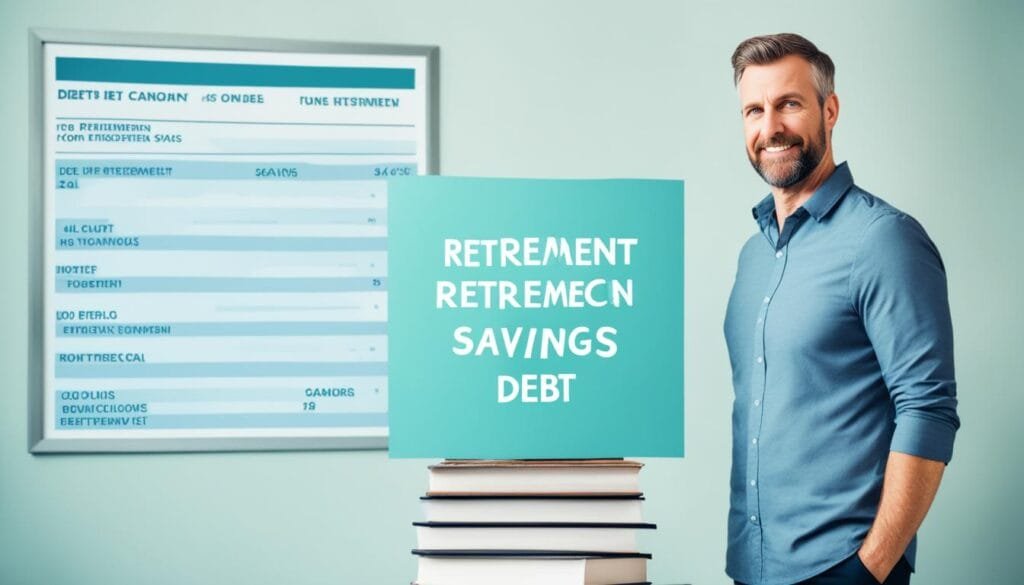Did you know that about 7 out of 10 Americans carry some form of debt, significantly impacting their financial decisions? This startling statistic highlights the common struggle many individuals face in deciding whether to prioritize debt repayment or invest in a 401(k) retirement plan. Understanding this financial planning dilemma is crucial for developing a sustainable financial strategy.
In an increasingly complex financial landscape, the choice between paying off high-interest debt and making contributions to a retirement savings plan can be daunting. With the average monthly Social Security benefit standing at $1,703.98 in July 20231, it’s evident that planning for retirement while managing existing debt is essential. The first step is recognizing how factors like interest rates and retirement goals influence this decision.
As we delve deeper into various aspects of debt and investment strategies, we aim to equip readers with the knowledge necessary to make informed financial decisions that align with their goals and long-term aspirations.
Key Takeaways
- Most Americans struggle with debt, impacting financial decisions.
- Understanding interest rates is essential for informed decisions.
- Social Security benefits reflect the need for robust retirement planning.
- Recognizing the difference between high and low-interest debt is crucial.
- Aligning short-term debt management with long-term investment goals can improve financial health.
The Financial Planning Dilemma: Debt vs. Investment
Individuals frequently encounter a financial planning dilemma when deciding whether to prioritize debt repayment or contribute to a retirement savings strategy. Balancing existing debts while aiming for secure retirement savings poses significant challenges. In the United States, household debt reached a staggering $16.5 trillion in the third quarter of 2022, which is more than $2 trillion higher than in 2019 prior to the pandemic2.
With average credit card interest rates soaring to 24.37% as of April 2024, the pressure to eliminate debt is intensified3. Individuals should consider the impact of high-interest debts on their capacity to save for retirement. It is advised to pay off high-interest credit card debt first in order to accelerate the debt repayment process3. Additionally, maintaining a credit utilization ratio below 30% is recommended to appear less risky to potential creditors2.
While many seek immediate relief from debts, overlooking a solid retirement savings strategy can have long-term consequences. Investments such as stocks, bonds, or mutual funds typically offer potential returns that need to be carefully weighed against existing debt interest rates3. Balancing these priorities is critical in the quest for financial health and retirement security.

Understanding Your Debt
When it comes to financial planning, understanding the types of debt you carry is crucial. Different debts, such as credit cards, student loans, and mortgages, can significantly impact your financial decisions and long-term goals. Around 43.2 million borrowers currently hold federal student loan debt, highlighting the substantial influence of student loans on budgeting and financial wellness4. Furthermore, the average credit card interest rate in late 2023 was approximately 21.47%, which can rapidly accumulate costs for individuals prioritizing debt payments4.
Types of Debt That Impact Financial Decisions
Debt categorization can offer insights into which obligations should be prioritized. Common categories include:
- Credit Card Debt: Typically features the highest interest rates.
- Student Loans: Federal loans may have lower rates, while private loans can be substantially higher.
- Mortgages: Generally offer lower rates but can significantly impact monthly cash flow.
- Personal Loans: Often come with rates above 12%, making them essential to address quickly4.
The Importance of Interest Rates in Your Decisions
Interest rates play a pivotal role in shaping financial strategies. For instance, the average stock market return is about 10% annually over the past century, while many debts accumulate interest at rates that greatly exceed this return rate4. Therefore, prioritizing debt payments, especially for high-interest obligations, can lead to more favorable financial outcomes than attempting to invest when the debt interest is higher than potential investment earnings. Those facing high-interest debts, especially with rates surpassing 10%, may need to adopt aggressive repayment strategies to avoid exacerbating their financial situations5 and6.

The Role of 401(k) Investments in Retirement Planning
Understanding the significance of 401(k) investments is vital for effective retirement planning. These plans provide various benefits including potential tax advantages and employer matching contributions, which are essentially free money. Maximizing 401(k) contributions plays a central role in securing a comfortable retirement, yet many individuals find themselves grappling with the question: should I pay off debt or invest in my 401(k)? This dilemma often requires careful consideration of one’s financial situation and long-term goals.
Maximizing 401(k) Contributions: What You Need to Know
To make the most of your 401(k), aim to contribute at least enough to obtain the full employer match. For instance, if your employer matches 50 cents for every dollar contributed up to 6% of your salary, taking advantage of this could yield a substantial return on your contributions, effectively making it a 50% return on your investment7. Additionally, knowing the annual contribution limits is essential; individuals can contribute up to $19,500, or $26,000 if they are 50 or older, enabling significant growth over time. Early contributions maximize the power of compounding interest, which can significantly enhance retirement savings.
Employer Matches: Is It Free Money?
Employer matches should not be overlooked as they represent a valuable opportunity to increase retirement savings without additional personal investment. If someone withdraws funds from a 401(k) before age 59½, a 10% penalty applies alongside income tax liabilities8. This makes it crucial to resist the temptation of withdrawing funds for debt repayment when such penalties can compromise long-term savings potential. Instead, consider redirecting funds back into your retirement contributions after addressing debts to avoid risking your financial future9. In conclusion, prioritizing maximizing 401(k) contributions while managing existing debt can provide a balanced approach to financial health.
Should I pay off debt or invest in my 401(k)?
Making a choice between debt repayment and investing in a 401(k) is a significant aspect of financial decision making. The decision should not be approached lightly; a thorough evaluation of your current financial situation is essential.
Evaluating Your Financial Situation Before Deciding
Every individual’s financial landscape is unique and requires careful consideration. Take into account your total household debt, which averaged $143,636 as of the first quarter of 2023, indicating a trend of rising total household debt10. Furthermore, understanding the interest rates tied to your debts is crucial. With credit card interest rates often hovering around 20%, it is clear that high-interest debt can severely impact your financial health10.
Comparative Analysis of Long-term Gains: Debt Repayment vs Investment
When assessing the potential long-term gains of debt repayment vs 401(k) investment, the prevailing advice leans towards a balanced approach. Experts suggest that investing early can leverage compounding interest for potentially higher returns than merely focusing on debt repayment10. However, financial experts also advocate paying down high-interest debt before contributing to retirement savings, as it may position you better for future financial opportunities11.
Implications of Interest Rates on Decision-Making
Interest rates can dramatically shape your choices in debt repayment and investment. Addressing high-interest debt can lead to better credit scores and lower monthly payments, freeing up cash for future investment opportunities11. A hybrid strategy, which entails managing both debt and 401(k) investments, allows for both short-term relief and long-term financial growth10. Evaluating your situation may involve establishing an emergency fund covering three to six months of expenses before making any substantial financial commitments11.
Prioritizing Debt Payments: A Strategic Approach
When faced with the decision of prioritizing debt payments, it becomes crucial to strategically analyze which debts carry the highest interest rates. Such an assessment ensures that individuals effectively manage their financial responsibilities while considering their long-term goals. Prioritizing debt payments can provide a pathway to financial freedom, ultimately leading to the question of whether one should pay off debt or invest in their 401(k) for future gains.
Identifying High-Interest Debt to Eliminate First
Begin by compiling all your debts and categorize them based on interest rates. Focus on eliminating high-interest debts first, such as credit card balances that can average 25% annually12. This strategy is essential because high-interest debts can significantly hinder your financial progress if not addressed promptly. Utilize methods like the avalanche method, which emphasizes paying off debts from the highest to the lowest interest rate, to reduce the overall interest paid over time13.
Creating a Sustainable Budget for Debt Repayment
Establishing a realistic budget is a foundational step in ensuring that debt payments fit comfortably within your financial plan. It is advisable to save a minimum of $1,000 initially while aiming to accumulate 3 to 6 months’ worth of essential expenses earmarked for emergencies13. This safety net prevents individuals from incurring additional debts during unforeseen circumstances. Allocate at least 15% of your pretax income towards long-term savings and consider the comparative interest rates of your debts against potential returns on investments, usually around 12% in an investment portfolio12. This balanced approach allows for steady debt repayment while indirectly preparing for a more secure financial future.
Investment Strategies: What to Consider
When navigating your financial landscape, understanding your investment strategies is essential for achieving your goals. A sound retirement savings strategy involves recognizing the power of compounding interest, which plays a pivotal role in investment growth over time. This approach enables you to build wealth exponentially, allowing your money to work for you.
Understanding Compounding Interest in Investment Growth
Compounding interest significantly impacts your returns, as it transforms both your principal and accumulated interest into a larger amount to earn further interest. Historical stock market returns indicate an average annual return of 9.5% over the last 90 years, far exceeding typical debt interest rates14. This growth strategy emphasizes the importance of investing early and consistently to maximize your retirement savings strategy.
Risk Tolerance: Aligning Investments with Financial Goals
Your risk tolerance directly influences your investment choices and financial decision making. Individuals with a higher risk appetite might opt for stocks, while conservative investors might gravitate toward bonds or fixed-income options. It is crucial to match your investment portfolio to your financial goals, particularly as your circumstances evolve over time. Consulting with a financial professional can provide insights tailored to your specific needs, especially in addressing debt with interest rates exceeding 5%, as it might be more beneficial to pay off such obligations before investing14.
| Investment Type | Potential Returns | Risk Level |
|---|---|---|
| Stocks | 9.5% (historical avg.) | High |
| Bonds | 4-6% | Moderate |
| High-Interest Debt Repayment | 24.06% (credit card avg.) | Very High |
| Real Estate | Varies (potential appreciation) | Moderate to High |
Ultimately, understanding both your financial goals and the nature of compounding interest can significantly enhance your investment strategies. This proactive approach not only aids in managing investments but also ensures a robust financial decision making process for your future.
Establishing a firm foundation with an emergency savings account further supports your financial health, allowing flexibility in your financial decision making while minimizing reliance on high-interest credit card debt15.
Balancing Debt Repayment and 401(k) Contributions
Finding the right balance between debt repayment and 401(k) contributions is a common financial planning dilemma faced by many. Effective allocation of funds is essential for not only maintaining financial stability but also for ensuring adequate retirement savings. Here are some practical strategies to consider.
Strategies to Allocate Funds Effectively
Creating a robust financial plan requires a thoughtful approach to managing both debt and investment. Start by prioritizing high-interest debts, such as credit cards, which can quickly accumulate financial strain. Allocating additional funds toward paying off these debts can lead to greater overall savings in the long run. For instance, almost 80% of millionaires consistently invested in employer-sponsored retirement plans like a 401(k), demonstrating that smart investment during wealth building is crucial16. Additionally, it’s important to consider life expectancy and financial planning when crafting a long-term financial strategy. As people are living longer, ensuring that your investments can sustain you throughout retirement becomes paramount. Diversifying investment portfolios and regularly reviewing financial goals can help protect your wealth and ensure it lasts as long as you do.
Consider implementing the following strategies for effective fund allocation:
- Establish an emergency fund covering three to six months of living expenses to avoid accumulating debt for unexpected costs11.
- Choose to contribute enough to your 401(k) to capture any employer match, as this can significantly enhance your retirement savings.
- Evaluate the interest rates on debts, as lower rates on mortgages typically allow more flexibility in debt management.
- Pay off high-interest debts first to create available credit for future use, thus regaining financial security.
Creating a Holistic Financial Plan
A comprehensive financial plan integrates both debt repayment and retirement savings goals, ensuring long-term financial health. Allocate a defined percentage of your income towards your 401(k) while simultaneously addressing debts. Research shows that individuals investing 15% of their income for retirement can accumulate almost $2.5 million by age 6716. This approach not only facilitates debt clearance but also enhances future financial security.
In crafting your plan, take advantage of budgeting tools and possibly seek the advice of financial specialists, ensuring tailored strategies align with personal goals and circumstances11.
Implementing these strategies fosters a balanced approach to debt repayment vs 401(k) investment, ultimately paving the path towards financial independence.
Conclusion
Deciding whether to pay off debt or invest in a 401(k) is a multifaceted challenge that requires careful assessment of personal financial situations. Individuals must evaluate their debt levels, especially considering that a debt-to-income ratio should ideally be no more than 36%17. Understanding the impact of different interest rates is crucial, as high-interest debts can negate savings from investment opportunities, particularly if that debt has a rate of 20%, which can be compared to earning a direct return on investment by paying it off18.
Creating a balanced approach is essential; statistical data shows that aggressive debt repayment strategies can save significant amounts in interest over time, as seen in scenarios where paying $500 a month on a $10,000 balance leads to a clear debt in two years with around $1,842 paid in interest, compared to $4,862 when paying only $25019. Furthermore, delaying investment, even briefly, can have substantial long-term consequences for wealth accumulation, suggesting that individuals should weigh the long-term benefits of investing in a 401(k) alongside managing their debt efficiently.
Ultimately, the key takeaway centers on informed decision-making; leveraging tax benefits, understanding the risk tolerance related to investments, and structuring budgets to support both debt repayment and retirement contributions are all vital elements for achieving financial health1917. Engaging with a financial advisor can also streamline this process, helping tailor strategies that align with individual goals and circumstances.
FAQ
Should I prioritize paying off debt or investing in my 401(k)?
What types of debt should I consider when making this decision?
How do interest rates influence my decision on debt repayment vs. 401(k) investment?
Can I do both, paying off debt and contributing to my 401(k)?
What is the significance of employer contributions to a 401(k)?
What should I evaluate in my financial situation before making a decision?
How can I create a budget for effective debt repayment?
What are the best investment strategies for retirement planning?
How can I ensure my financial plan addresses both debt repayment and retirement savings?
Source Links
- https://humaninterest.com/learn/articles/should-i-contribute-to-my-401k-or-pay-off-debt/
- https://fortune.com/recommends/investing/pay-down-debt-or-invest/
- https://www.investopedia.com/articles/pf/08/invest-reduce-debt.asp
- https://eringobler.com/pay-off-debt-or-save-for-retirement/
- https://www.schwab.com/learn/story/should-you-save-retirement-or-pay-off-student-loans
- https://www.bankrate.com/investing/use-retirement-savings-to-pay-debt/
- https://www.forbes.com/advisor/retirement/pay-debt-or-save-for-retirement/
- https://www.investopedia.com/articles/retirement/10/paying-off-debt-401k.asp
- https://www.cnbc.com/select/lower-retirement-contribution-pay-off-debt/
- https://www.newyorklife.com/articles/pay-off-debt-or-invest
- https://www.debt.org/retirement/prioritize-savings-vs-payoff/
- https://point.com/blog/is-it-better-to-pay-off-debt-or-save
- https://www.fidelity.com/viewpoints/personal-finance/how-to-pay-off-debt
- https://www.ellevest.com/magazine/budget-and-planning/debt-vs-investing
- https://www.nationwide.com/lc/resources/investing-and-retirement/articles/pay-off-debt-or-save
- https://www.ramseysolutions.com/debt/pay-off-debt-before-retirement
- https://www.truist.com/money-mindset/principles/outsmarting-debt/pay-off-debt-or-invest
- https://www.brightmoney.co/learn/is-it-better-to-invest-or-pay-off-debt-first-for-retirement
- https://smartasset.com/investing/pay-off-debt-or-invest

